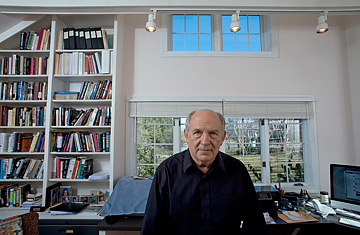
The hermit of Burkittsville. Murray gets perhaps one call a week at his rural Maryland home
(4 of 6)
Murray's intuition was that the opposite trajectories of these two increasingly isolated white worlds could be described statistically over time, and in the midst of a brainstorm, he called the elite one Belmont, after a rich suburb of Boston, and the poor one Fishtown, after a white working-class neighborhood of Philadelphia. (He initially had a Middletown, which would trace the arc of the middle class, but discarded it because it made the graphs too complicated.) As he traced these two cultures over time, Murray found an arresting set of patterns. The 1970s destabilized both Belmont and Fishtown: divorce became more common, churchgoing declined, and Americans' interest in working seemed to diminish. But by the mid-1980s, these indicators seemed to stabilize in Belmont; meanwhile, the bottom fell out in Fishtown. In 1969, less than 10% of men in Fishtown were not making a living; now the figure was roughly 30%. Fifty years ago, 95% of Fishtown's children were living with both biological parents; now it is only 1 in 3. Murray came to think of the difference between Belmont and Fishtown in terms of what he calls "the founding virtues": marriage, honesty, industriousness and churchgoing. These, he says, were to the Founding Fathers the underpinnings of an informed citizenry and a successful democracy. In Belmont they were flourishing; in Fishtown, disappearing.
Fishtown, as it happens, is a real place on the Delaware River, just a few minutes north of downtown Philadelphia, a neighborhood that for much of the 20th century had never been rich but always remained cohesive. But visiting the present-day Fishtown, Murray found stories of three teenage sisters, all pregnant at the same time; of small-factory owners who could not find willing workers in a neighborhood filled with the unemployed; of schoolteachers who noted that most of their students' parents had no job. "These are not communities that can solve their own problems anymore," he says. "They are becoming communities that require a welfare state. And that's real sad."
Murray believes that the "fierce pride" that once characterized Fishtown has faded. "Insofar as you have the women of Fishtown looking at the men around them and saying they're feckless. And insofar as you do have the women of Fishtown subsisting off of sort-of jobs beneath the table and certain kinds of public assistance, it's hard to have that fierce pride."
For Murray, the problems of Belmont's isolation and Fishtown's decline are connected. To the elite, he says, Fishtown might as well be a foreign country--to many, it may actually be less interesting than foreign countries--and so its problems remain unknown and neglected. "The fact is, I'm pretty pessimistic," he says. "I hope I'm wrong. But I'm probably not."
"A Brutal Disregard"
There are signs of this white cultural isolation and drift everywhere in the current recession--in reality shows about the meth-ravaged heartlands, films like Winter's Bone and documentaries like The Wild and Wonderful Whites of West Virginia. But is there really a special crisis in the white working class, or are communities like Fishtown simply vivid examples of the broader economic distress?
